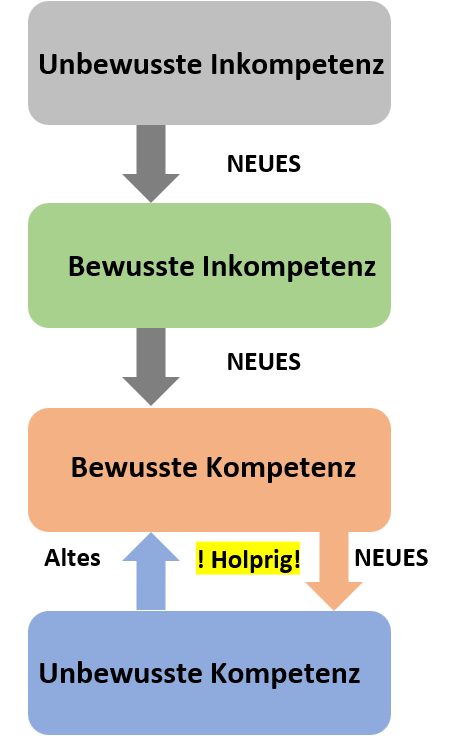The 4 Stages of Competence
The four stages of competence is a learning model from developmental psychology that illustrates the path from incompetence to competence.
The 4 Stages of Competence
A tribe living outside civilization resides in the forests near a beach by the Indian Ocean. One day, some tribe members discover a strange object washed ashore while fishing.

They pull out the strange object and bring it to their chief. The chief has never seen such an object before. He touches it. He even smells it. But he faces something entirely new to him.
The chief's ambition is sparked. He is determined to find out what this unknown object is. He spends a lot of time with it. He sees two round, black parts with a yellow frame. Something padded with a strange shape is mounted on the frame. The frame is designed so that the front round part can move left and right.
He stands the object upright on the two round parts and notices they spin. The object moves when pushed. Not far. Soon it falls to the side. The chief goes to bed thoughtful. He is disappointed he hasn't figured out what the object is or how to use it.
The next day, the chief engages with the object again. He sits on the padded part with the strange shape on the frame. He pushes with his feet and rolls a few meters. And he is happy. After more attempts, the chief notices two parts sticking out from the object, perfect for resting his feet. He holds onto the front part of the frame, pushes hard, and places his feet on the side parts. He realizes he can steer with his arms. Soon, he falls over with the object. He tries again. And falls again. On the next try, he moves his legs and notices the parts under his feet move too. The object seems to move faster when he does this. As soon as the object slows, the chief falls again.
The chief practices almost nonstop to use this unknown object as a means of transport. He travels everywhere with his new vehicle. He still needs to concentrate hard and sometimes falls, but overall, it works well.
After some practice, the chief no longer thinks about how to ride the object. Automatically, he makes the right moves at the right time.
The story of the chief and the bicycle clearly illustrates the four stages of competence.

Unconscious Incompetence
This is the first stage of competence. In this phase, a person doesn't know they lack knowledge or skills. New input moves them to the second stage.
Until the chief saw the bicycle, he didn't know he couldn't ride one, let alone that such vehicles existed. Realizing his ignorance moved him to the second stage of competence.
Conscious Incompetence
This is the second stage of competence. In this phase, a person knows they lack knowledge or skills. New input and repetition lead to the third stage.
The chief didn't know how to ride a bicycle. By engaging with it, he learned how to operate it. He knew how to use the bicycle and moved to the third stage of competence.
Conscious Competence
This is the third stage of competence. In this phase, a person knows they have knowledge or skills. Exercises are done in this phase. The goal is to reach the final stage of competence.
The chief rode his bicycle everywhere. He practiced more and more until it worked without thinking about it. He reached the fourth stage of competence.
Unconscious Competence
This is the fourth and final stage of competence. In this phase, knowledge is applied automatically, or tasks are performed automatically.
Unconscious Competence in the Seminar Context
Since exercises are done in the third stage, experienced participants often need to be "brought back" from the last to the third stage in seminars. This can lead to resistance because they have automated the knowledge and may not see the benefit of doing things differently. Participants should be individually addressed and appreciated in this situation. Their individual benefits should also be explained.
You can already do it in way A and have fully automated it, as shown by your successes A and B. But if I show you another way that could give you benefits A and B too, would that be okay with you?
